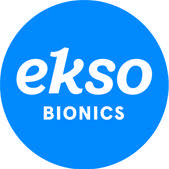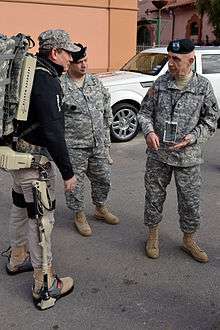Ekso Bionics
 | |
| Public | |
| Traded as | OTCQB: EKSO |
| Founded | 2005 |
| Founder | Homayoon Kazerooni, Russ Angold, Nathan Harding |
| Headquarters | Richmond, California, United States |
Key people | Thomas Looby (CEO) |
| Website |
www |
Ekso Bionics develop and manufacture powered exoskeleton bionic devices that can be strapped on as wearable robots to enhance the strength, mobility, and endurance of soldiers and paraplegics. These assistive robots have a variety of applications in the medical, military, industrial, and consumer markets. It enables individuals with any amount of lower extremity weakness, including those who are paralyzed, to stand up and walk.
The company's first commercially available product is called Ekso. Ekso Bionics is the original developer of HULC, now under military development by Lockheed Martin, and the current developers of Ekso (formerly eLEGS), which allows wheelchair users to stand and walk.
Ekso was selected as WIRED magazine's number two "Most Significant Gadget of 2010",[1] and was included in Time magazine's "50 Best Innovations of 2010".[2] Ekso Bionics was also featured in Inc. Magazine as one of "5 Big Ideas for the Next 15 Years".[3]
Background

The company was founded in 2005 under the name of Berkeley ExoWorks by Homayoon Kazerooni, Russ Angold and Nathan Harding, all members of the Berkeley Robotics and Human Engineering Laboratory at the University of California.[4] Berkeley ExoWorks introduced ExoHiker and ExoClimber, both with a weight carrying capacity of 150 pounds.[5]
In 2007 the company changed its name from Berkeley ExoWorks to Berkeley Bionics. Berkeley Bionics developed an untethered, hydraulically powered exoskeleton they called the Human Universal Load Carrier (HULC), and which could carry heavier loads than the previous models. The HULC system was announced publicly at the AUSA Winter Symposium on February 26, 2009 when an exclusive licensing agreement was reached with Lockheed Martin. Berkeley Bionics also debuted eLEGS, an intelligent, bionic exoskeleton that allows wheelchair users to stand and walk.
In 2011 Berkeley Bionics changed its name again, to its current name Ekso Bionics. It also changed the name of eLegs to Ekso.
In 2012, Ekso suits were registered as a class l device for hospital use in the US, and received a CE marking from the E.U.[6][7]
In 2013, Ekso Bionics added Variable Assist, an intelligent and adaptive software providing the ability to provide adaptive amounts of power to either side of the body, making them unique in the field of medical exoskeletons.[8]
In 2014, Ekso Bionics became a public company.[9]
In 2015, Ekso Bionics began to develop new market with industrial prototype. Continues to expand into leading rehabilitation hospitals.[10]
In 2016 Ekso Bionics appointed Thomas Looby interim chief executive officer, continues commercialization drive.[11]
Products
HULC
|
| |
|
|
In 2009 Berkeley Bionics unveiled HULC, which stands for Human Universal Load Carrier. HULC is a more sophisticated and capable development of the above projects. It can carry a 200-pound load, and reduces the metabolic energy needed by the wearer to perform a given task. "In this way the device can significantly increase the range and length of tasks the wearer can perform."[5][12]
In particular, HULC has potential military uses, and in 2009 a licensing and development agreement was reached with Lockheed Martin.[13]
HULC lends itself to augmentation with devices that can be mounted on the back of its exoskeleton. One such device, the Lift Assist Device, lets operators carry front loads as well as loads on their back. It also "allows single operators to lift heavy loads that currently require two or more people".[14]
Ekso (or eLEGS)
| Images | |
|---|---|
|
| |
| Video | |
|
| |
|
|
In 2010 Berkeley Bionics unveiled eLEGS, which stands for "Exoskeleton Lower Extremity Gait System". eLEGS is another hydraulically powered exoskeleton system, and allows paraplegics to stand and walk with crutches or a walker. The computer interface uses force and motion sensors to monitor the user's gestures and motion, and uses this information to interpret the intent of the user and translate it into action. Users can "put on and take off the device by themselves as well as walk, turn, sit down, and stand up unaided".[15]
In 2011 eLEGS was renamed Ekso. Ekso weighs 45 pounds (20 kg), has a maximum speed of 2 mph (3.2 kph) and a battery life of 6 hours. It is suitable for users weighing up to 220 pounds, who are between 5 ft 2in and 6 ft 4in tall and can transfer themselves from a wheelchair to a chair. It allows the user to "walk in a straight line, stand from a sitting position, stand for an extended period of time, and sit down from a standing position".[16]
In 2013 The next generation Ekso GT with smart Variable Assist™ (marketed as SmartAssist outside the U.S.) software was released. It is the only exoskeleton available for rehabilitation institutions that can provide adaptive amounts of power to either side of the patient’s body, challenging the patient as they progress through their continuum of care. The suit’s patented technology provides the ability to mobilize patients earlier, more frequently and with a greater number of high intensity steps.
See also
Notes
- ↑ The 10 Most Significant Gadgets of 2010 WIRED, 29 December 2010.
- ↑ The 50 Best Inventions of 2010 Time, 11 November 2010.
- ↑ Meet the Makers of the Wearable Robot Inc. Magazine, 30 October 2012.
- ↑ Timeline Ekso Bionics main web site. Retrieved 30 January 2012.
- 1 2 Lab Report XVI Metropolis Magazine, 18 December 2011.
- ↑ http://www.technobuffalo.com/2012/01/15/ekso-bionic-exoskeletons-help-spinal-chord-injured-walk-again/
- ↑ http://www.parker.com/literature/Exoskeleton/Pages%20from%20PInnacle-Fall-2012-FINAL.pdf
- ↑ https://healthmanagement.org/c/icu/news/ekso-bionics-announces-new-utility-for-bionic-suit
- ↑ http://www.mddionline.com/article/5-startups-poised-change-medtech-forever-ekso-bionics
- ↑ http://time.com/4189590/exoskeleton-super-strength-ekso-bionics/
- ↑ https://globenewswire.com/news-release/2016/02/25/814125/0/en/Ekso-Bionics-Appoints-Thomas-Looby-to-Interim-Chief-Executive-Officer.html
- ↑ HULC Berkeley Robotics and Human Engineering Laboratory. Retrieved 29 January 2012.
- ↑ Lockheed Martin Unveils Exoskeleton Technology at AUSA Winter Symposium Lockheed Martin, 26 February 2009.
- ↑ ULCTM with Lift Assist Device Berkeley Robotics and Human Engineering Laboratory, 2010.
- ↑ eLEGS Berkeley Robotics and Human Engineering Laboratory. Retrieved 29 January 2012.
- ↑ Exoskeleton Berkeley Bionics. Retrieved 29 January 2012.
Other references
- Robotic devices help paralyzed become more independent USA Today, 6 January 2012.
- Meet the Real Bionic Man Wall Street Journal, 22 October 2011.
- Walking Again, With Help From an Exoskeleton New York Times, 3 November 2011.
- US researchers create suit that can enable paraplegics to walk The Engineer, 25 October 2011.
- Johnson, Carolyn Y. With device’s aid, the paralyzed take steps anew The Boston Globe, 15 September 2011.
- Wearable robot puts paralysed legs through their paces" Wired UK, 17 January 2012.
- Strickland, Eliza (2012) "Good-bye, Wheelchair, Hello Exoskeleton" IEEE Spectrum, 49 (1): 30–32.
External links
- The next step in bionics CBS News, 9 October 2011.
- Wearable Robot Helps Paralyzed Detroit Firefighter Walk, Fox News, 6 January 2012.
- Making Strides 60 Minutes (Australian TV), 5 August 2011.
- Are Exoskeletons "Ableist"? Institute for Ethics and Emerging Technologies, 28 January 2012.
- Audio interview with Russ Angold, co-founder and CTO of Ekso Bionics Robots Podcast 25 July 2014